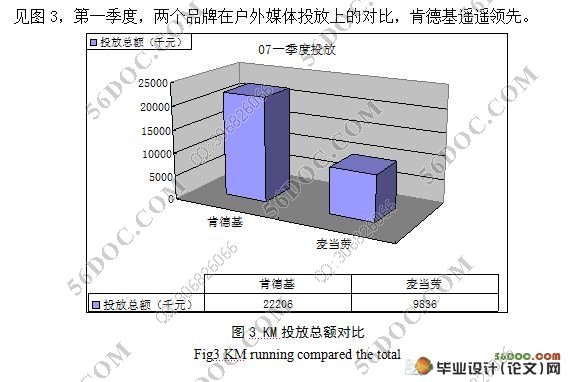奥运广告投放的效益分析
来源:56doc.com 资料编号:5D6757 资料等级:★★★★★ %E8%B5%84%E6%96%99%E7%BC%96%E5%8F%B7%EF%BC%9A5D6757
资料以网页介绍的为准,下载后不会有水印.资料仅供学习参考之用. 密 保 惠 帮助
资料介绍
奥运广告投放的效益分析(12000字)
摘 要:奥运商业化运作的内在动因是其蕴有的巨大经济效益,而奥运商业化运作的核心要素则是其被世界传媒和跨国企业所看重与追求的全球广告平台和无可比拟的广告传播效应。国际著名跨国企业竞相签约奥运全球赞助商的根本原因是奥运品牌的广告效应,国内企业也是这样。奥运广告投放是每个赞助商与非赞助商所追求的目标都是经济效益最大化。本文首先建立有关广告投放量与潜在购买力的数学模型;其次,通过数据分析以案例形式来研究最优的广告投放;最后探讨盛大赛事期间的广告投放的效益分析的限制条件及未来和展望,更好的挖掘赛事期间的广告投放的效益分析的潜能。
关键词:奥运广告;经济效益;广告效果;博弈
Benefit Analysis of the Olympic Advertisement
Abstract: The Olympic commercial operation of intrinsic motivation is its huge economic benefits .The Olympic core element of business operation is the pursuit of global advertising platform and unparalleled advertising effect. And it is being the world's media and multinational corporations are valued and pursued. Well-known because of the Olympic brand advertising effects, the multinational corporations and the domestic enterprises compete to sign the international Olympic global sponsors. The target of Olympic advertising that each sponsor and non-sponsors are pursued is the maximal economic benefits. Firstly, this paper established the mathematical model of the ads volume and potential purchasing power . Followed by we analysis the data of case, so as to study the optimal advertising. Lastly, the constraints and the future of the advertising benefits during the gala event is analysis. And we can analysis of the potential benefits of advertising during excavation event.
Keywords: Olympic advertising; Economical benefits; Advertising effectiveness; Game

目 录
摘要……………………………………………………………………………1
关键词……………………………………………………………………………1
1前言……………………………………………………………………………………2
2 广告中的数学……………………………………………………………………… 3
2.1 定义解释………………………………………………………………………… 3
2.2 模型假设………………………………………………………………………… 3
2.3 模型建立………………………………………………………………………… 3
2.4 模型求解………………………………………………………………………… 5
2.5 实例分析………………………………………………………………………… 5
3 奥运赞助商与非赞助商的博弈…………………………………………………5
4实际案例分析………………………………………………………………………10
5科学合理的进行广告投放…………………………………………………………14
6 结论……………………………………………………………………………15
参考文献……………………………………………………………………………15
致谢…………………………………………………………………………16
|



